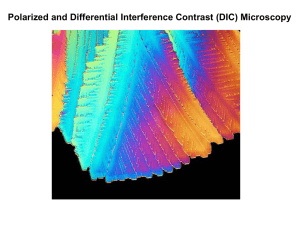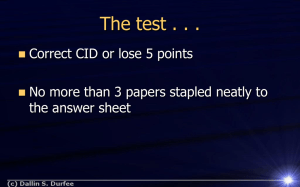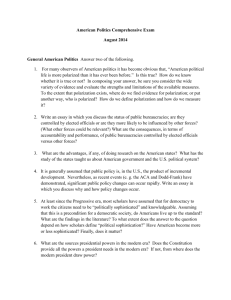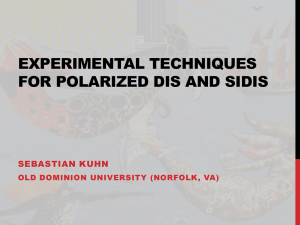Workshop summary PSTP2011 - XIV International Workshop on
advertisement
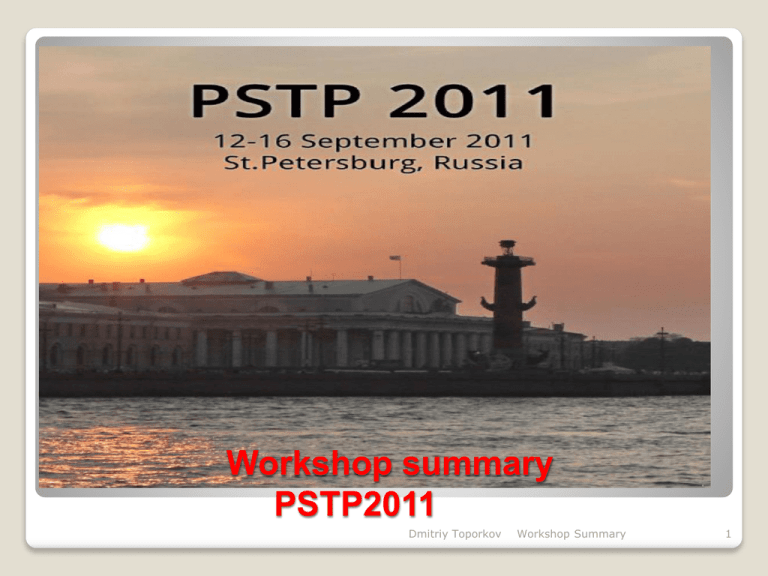
Workshop summary PSTP2011 Dmitriy Toporkov Workshop Summary 1 International spin physics committee: Steffens E., Erlangen (Chair) Roser T., BNL (Past-Chair) Milner R.G., MIT (Chair-Elect) Anselmino M., Torino Belov A.S., INR Bradamante F. *, Trieste Courant E.D. *, BNL Crabb D.G. *, Virginia Gao H., Duke Efremov A.V., JINR Fidecaro G. *, CERN Haeberli W. *, Wisconsin Imai K., Kyoto Krisch A.D., Michigan Lenisa P., INFN Mallot G., CERN Masaike A. *, Kyoto van Oers W.T.H. *, Manitoba Poelker M., JLAB Prepost R., Wisconsin Prescott C.Y. *, SLAC Saito N., KEK Sakai H., Tokyo Soergel V. *, Heidelberg Stephenson E.J., Indiana Stroher H., COSY Tyurin N.E., IHEP * Honorary Members Dmitriy Toporkov Workshop Summary PSTP2011 Scientific sessions Session 6 Talks Session 5 Talks Session 4 Talks Session 3 Talks Session 5 Talks Session 6 Talks 1: Polarized electron sources (chair E. Tsentalovich) 2: Polarimetry (chair: Y. Makdisi) 3: Polarized internal targets, ABS (chair D. Toporkov) 4: Polarized ion sources (chair A. Belov) 5: Prospects of polarized experiments (chair E. Steffens) 6: Polarized solid targets (chair D. Crabb) Dmitriy Toporkov Workshop Summary Status of Spin Physics and Experiments Erhard Steffens University of Erlangen-Nürnberg Chair, International Committee for Spin Physics Symposia DIS Diffraction Material science with pol. neutrons SPIN TOOL S Nucl. structure Spin tools are discussed in detail at Workshops (regular or topical) Spin structure Dmitriy Toporkov Workshop Summary 4 Polarized electron sources Eric J. Riehn, BNL Dmitriy Toporkov Workshop Summary 5 Period Dependence of Time Response of Strained Semiconductor Superlattices Leonid G. Gerchikov State Polytechnic University, St. Petersburg, Russia Partial electron localization leads to non-exponential decay of pulse response. Analysis of pulse response allows to determine the characteristic times of capture and detachment processes. Partial electron localization decreases considerably the diffusion length in SL Partial electron localization limits QE for thick working layer. For practical application one should employ SL photocathodes with no more than 10 – 12 periods. Dmitriy Toporkov Workshop Summary 6 Dmitriy Toporkov Workshop Summary 7 Status of high intensity polarized electron gun project at MIT-Bates Evgeni Tsentalovich, MIT Current status The gun chamber: built and tested. It was vented 3 weeks ago to install the first dipole followed the gate valve and 2 additional NEGs. Rebaked and HV reprocessed. The preparation chamber: design is completed, the main chamber has been manufactured, many parts are already ordered. Load lock – the design is in progress. Beam line – conceptual design is completed, some parts are designed, the dipole vacuum chambers have been manufactured. Dmitriy Toporkov 1 0.8 0.6 0.4 0.2 0 -6 -4 -2 0 2 4 6 R,mm Workshop Summary 8 Marcus Wagner Dmitriy Toporkov Workshop Summary 9 Commissioning results of the SRF gun with Pb cathode R. Barday, HZB Development of the SRF gun in a staged approach few hunderd nm thick Pb cathode film Beam energy 50 MeV Average current 100 mA Bunch charge 77 pC Normalized emittance Repetition rate <1 mm mrad 1.3 GHz Energy Recovery Linac BERLinPro Dmitriy Toporkov Workshop Summary 10 Polarimetry Polarized beam in RHIC in Run 2011.Polarimetry at RHIC A.Zelenski, BNL Faraday rotation polarimeter Lamb-shift polarimeter 200 MeV - absolute polarimeter AGS p-Carbon CNI polarimeter RHIC p-Carbon CNI polarimeter RHIC - absolute H-jet polarimeter Local polarimeters at STAR and PHENIX Dmitriy Toporkov H-jet is an ideal polarimeter ! High (~4.5%) analyzing power in a wide energy range (23-250 GeV). High event rate due to high intensity (~100 mA) circulated beam current in the storage ring (~6% statistical accuracy in one 8hrs. long fill Workshop Summary 11 Polarized beams in RHIC A.Zelenski, BNL Source, Linac, AGS-injector polarimetrs. Hjet: Absolute polarization measurements Absolute normalization for other RHIC Polarimeters pC: Separate for blue and yellow beams Normalization from HJet Polarization vs. time in a fill Polarization profile Fill-by-fill polarizations for experiments PHENIX and STAR Local Polarimeters: Monitor spin direction (through transverse spin component) at collision Polarization vs time in a fill (for trans. pol. beams) Polarization vs bunch (for trans. pol. beams) Dmitriy Toporkov Workshop Summary 12 Extra Physics with an Atomic Beam Source and a Lamb-Shift Polarimeter Ralf Engels, JCHP / Institut für Kernphysik, FZ Jülich PIT@ANKE Bound β decay Precision Spectroscopy of H and D Polarized Molecules Dmitriy Toporkov Workshop Summary 13 Proton Polarimetry at the Relativistic Heavy Ion Collider and Future Upgrades Yousef I. Makdisi, Brookhaven National Laboratory For the RHIC Polarimetry Group 31 GeV 100 GeV 250 GeV 24 GeV: PRD 79, 094014(2009) 31 GeV: Preliminary 100 GeV: PLB 638 (2006) 450 250 GeV: Preliminary Weak energy dependence pC elastic scattering in CNI region is good for polarimetry in wide beam energy range Dmitriy Toporkov Weak (if any) energy dependence pp elastic scattering in CNI region is ideal for polarimetry in wide beam energy range Workshop Summary 14 Systematic Errors Studies in the RHIC/AGS Proton-Carbon CNI Polarimeters Andrei Poblaguev, Brookhaven National Laboratory summary • Different types of detectors were tested in the Run 2011 • Results of polarization measurements were consistent within 1-2% accuracy • No significant variation of the results of measurements were observed during the whole 4 month run. • The polarimeter has a capability to measure analyzing power up to the arbitrary normalization factor, but accurate study of the systematic errors is needed for that. • Standard energy calibration method was found to be unreliable, new method of calibration are suggested but more development is still needed. • Experimental evaluation of the rate effect is consistent with estimation of pileup contribution. • More accurate control of energy losses in the target is needed. Dmitriy Toporkov Workshop Summary 15 POLARIZED INTERNAL TARGETS and ABS Storage cells for internal experimentswith Atomic Beam Source at the COSY storage ring Kirill Grigoryev Institut für Kernphysik, Forschungszentrum Jülich, Germany Petersburg Nuclear Physics Institute, Gatchina, Russia dimensions 15x20x370 (140+230) mm3 material 25μm Al + 5μm Teflon Atomic hydrogen target density - 1.34 · 1013 at/cm2 11x11x390 (190+200) mm3 25μm Al + 5μm Teflon Openable storage cell configuration: dimensions material Fixed storage cell configuration: Expected atomic hydrogen target Dmitriy Toporkov - 4.7 · 1013 at/cm2 Workshop Summary 16 A.Belov, INR RAS Dmitriy Toporkov Workshop Summary 17 Possibility to obtain a polarized hydrogen molecular target D. Toporkov BINP, Novosibirsk, Russia Summarry Suggested source of polarized molecules Intensities of polarized beams from the Atomic Beam sources seems have reached it’s limit of about 1017at/sec. Proposed source of polarized ortho-hydrogen (o-H2 ) molecules probably will provide intensity by order of magnitude higher. An opening questions are preservation of polarization of molecules under injection into the storage cell and realization of huge differential pumping system needed to get good vacuum condition. Dmitriy Toporkov Workshop Summary 18 Modification of the Pumping System of the Polarized Atomic Beam Source (ABS) at the ANKE facility in COSY- Jülich Viplav Gupta, IKP/Jülich, Jülich Center for Hadron Physics, FZJülich,Germany Current Status • Installation at a test chamber • All components tested successfully • Pressure achieved in the system ≈ 3*10-8 mbar All 3 cryogenic pumps are to be replaced by 4 turbomolecular pumps made available from previous experiments Dmitriy Toporkov Workshop Summary 19 POLARIZED ION SOURCES High-Intensity Polarized H- Beam production in Charge-exchange Collisions A.Zelenski, BNL Atomic H injector produces an order of magnitude higher brightness beam than present ECR source. A 5-10 mA polarized H- ion current (50-100 mA proton current) can be obtained for the smaller (higher brightness) beam. The basic limitation on the production of the high-intensity (~300 mA) , high-brightness unpolarized H- ion beam in charge – exchange collisions will be also studied. Higher polarization is expected with the fast atomic beam source due to: a) elimination of neutralization in residual hydrogen; b) better Sona-transition efficiency for the smaller diameter beam; c) use of higher ionizer field (up to 3.0 kG), while still keeping the beam emittance below 2.0 π mm∙mrad, due to the smaller beam diameter. All these factors combined will further increase polarization in the pulsed OPPIS to over 85%. Dmitriy Toporkov Workshop Summary 20 Status of the Source of Polarized Ions for the JINR accelerator complex V.V. Fimushkin Joint Institute for Nuclear Research, Dubna Extraction chamber hard ware status ready Charge-exchange plasma ionizer hard ware status 70%ready ABS hard ware status ready The new flagship JINR project in high energy nuclear physics, NICA (Nuclotron-based Ion Collider fAcility), aimed at the study of phase transitions instrongly interacting nuclear matter at the highest possible baryon density, was put forward in 2006 Intensive work on preparation of the ABS for tests is carried out at INR of RAS (Moscow) Operating tests of the ABS systems are planned in 2011 The first tests of the SPI charge-exchange ionizer at JINR are planned in 2011 also Dmitriy Toporkov Workshop Summary 21 A.Holler, Julich Dmitriy Toporkov Workshop Summary 22 Prospects of polarized experiments Yu.Kiselev Dmitriy Toporkov Workshop Summary 23 Precursor experiments to search forpermanent electric dipole Moments (EDMs) of protons and deuterons at COSY Frank Rathmann, Juelich A permanent EDM of a fundamental particle violates both parity (P) and time reversal symmetry (T). Assuming CPT to hold, the combined symmetry CP is violated as well. PE 1: Use a combination of a snake and RF fields PE 2: Dual Beam Method (equivalent to g-2 d) for p and d PE 3: Resonance Method with RF E-fields PE 4: Resonance Method of EDM Measurements in SR Next step: • Scrutinize potential of different Principal Experiments Systematic error estimates for all PEs require reliable spin tracking tools. Top priority to make them available ASAP! • Identify PE with best systematic limit on dp,d. Dmitriy Toporkov Workshop Summary 24 A possible way to measure the deuteron EDM at COSY N.Nikolaev (IKP FZJ & Landau Inst) “Freeze“ horizontal spin precession; watch for development of a vertical component ! A magic storage ring for protons (electrostatic), deuterons, … The deuteron EDM < 1 E-24 e cm is within the reach of COSY supplemented by RFE-flipper running at approx. 5 % of the ring frequency Similar upper bound is feasible for the proton An obviously long way from an ideal ring to the real thing plagued by systematics But there is an in situ access to sytematics via the magnetic moment of the deuteron (proton...) Dmitriy Toporkov Workshop Summary 25 First experiments with the polarized internal gas target at ANKE/COSY Maxim Mikirtychyants for the ANKE collaboration FZ Jülich / JCHP and PNPI (Gatchina) What makes the difference in positive and negative polarization? Summary Target performance Reliable operation High target density High polarization Polarimetry Online HFT tuning using the LSP Online data analysis procedure Instruments Point-like target (jet) Unpolarized Gas Supply System (background measurements) Dmitriy Toporkov Workshop Summary 26 DOUBLE POLARIZED DD-FUSION P. Kravtsov, Petersburg Nuclear Physics Institute, Gatchina, Russia 3 2+ He (0.8 MeV), 3 + Polarized Atomic Beam Source H (1.0 MeV) ABS based on SAPIS project ABS (from Cologne University) I ~ 1 ∙ 1016 a/s Target density ~ 1011 a/cm2 Vector polarization: ± 0.7 d 0 (0.1 eV) dd-polarimeter or LSP d + r r d 0+d + ® 3 He + n + e 3 2+ d + (1-32 keV) H+ + p+e Wien filter d 0 (0.1 eV) LSP n (2.4 MeV), p (3.0 MeV) Ion source Polarized Ion Source based on POLIS source (KVI, Groningen) Ion beam: I ≤ 20 μ A (1.3 ∙ 1014 d/s) Ebeam ≤ 32 keV Vector polarization: ± 0.7 Lamb-Shift Polarimeter Starting experiment 2012-2013 Dmitriy Toporkov Workshop Summary 27 Perspectives for Polarized Antiprotons Paolo Lenisa, Università di Ferrara and INFN – ITALY, on behalf of the PAX-Collaboration September 2011 ongoing beamtime: II Ring polarization studies I. Measurement of polarization lifetime: tP>105s II. Measurement of spin-flip efficiency: e=0.987 W AS A ecoolAN er KE P A X Dmitriy Toporkov Workshop Summary 28 Polarized solid target PNPI polarized target for pion-nucleon scattering measurements at intermediate energies D.V. Novinsky Petersburg Nuclear Physics Institute, Gatchina, Leningrad district, 188350, Russia method of proton magnetic resonance (PMR), polarization pump by the dynamic nuclear orientation method up to absolute value 70–80% measurements are based on the calculations of square under the PMR curve: the system containing Q-meter with sequential contour and signal digitalization Calibration is based on the equilibrium state at temperature 0.8 – 1.4 K Dmitriy Toporkov Successful target work > 20 years Modernization and new tests are required New physics tasks In memory of A.I. Kovalev (1936-2011) Workshop Summary 29 Alexander Berlin, Ruhr Universitat Bochum Conclusion Dmitriy Toporkov Workshop Summary 30 G.Reicherz Dmitriy Toporkov Workshop Summary 31 The polarized solid target for the cristal ball experiment at MAMI A.Thomas Dmitriy Toporkov Workshop Summary 32 Development of polarized HD target for LEPS experiments Hideki Kohri , RCNP Osaka University Japan First production of polarized HD target Summary and future plan (2008Nov-2009Jan Purity of HD: about 99% Temperature : T = 14 mK Magnetic Field : B = 17 Tesla Aging time : 53 days Expected Polarization : 80%(H) Measured Polarization : 40%(H) Measured relaxation time (T1) : 100 days We are developing a polarized HD target. We tried to produce the polarized HD target in 2009. Although the polarization degree was small(40%), the relaxation time was long enough for LEPS experiments. We developed new NMR system, gas analyzer system, and gas distillation system for future production of polarized HD target. These systems are working well. We plan to carry out an experiment using polarized HD target in the next year. We constructed a new beam-line (LEPS2) at SPring-8. The BNL/E949 spectrometer will be transported to SPring-8 in this year. Dmitriy Toporkov Workshop Summary 33 Polarized solid 3He target created by the brute force method for medical use Masayoshi Tanaka, Department of Clinical Technology, Kobe Tokiwa University, Kobe, Japan To reduce the risk arising from the radiation This is our motivation to start the “NSI” (Nuclear Spin Imaging ) - MRI with the Hyperpolarized Nuclei. Basically, the NSI uses a polarizer and conventional MRI, no need for constructing a new device except for the polarizer itself. Conclusion The technical part of the first step, i.e. experimental verification of production of the hyperpolarized 3He is on going. Future prospect I. Practical use of hyperpolarized 3He-MRI for medical diagnosis: 1) Basic study on lung, e.g., ventilation Time dependence 2) Medical diagnosis for COPD (Chronic Obstructive Pulmonary Disease) with ADC (Apparent Diffusion Coefficient) etc. Dmitriy Toporkov Workshop Summary 34 I would like to thank to the members of Program Committee who help me a lot during the preparation of the program Alexander Belov Ralf Engels Frank Rathmann Erhard Steffens Masayoshi Tanaka Eugeni Tsentalovich Dmitriy Toporkov Workshop Summary 35 Final remark We had an excellent week with inspiring talks and discussions. Alexander and the organizers did a fantastic job! Many thanks to the Local organizing committee: Alexander Vasilyev Mariya Marusina Eugeniya Brui Peter Kravtsov Kirill Grigoriev Dmitriy Toporkov Workshop Summary 36



